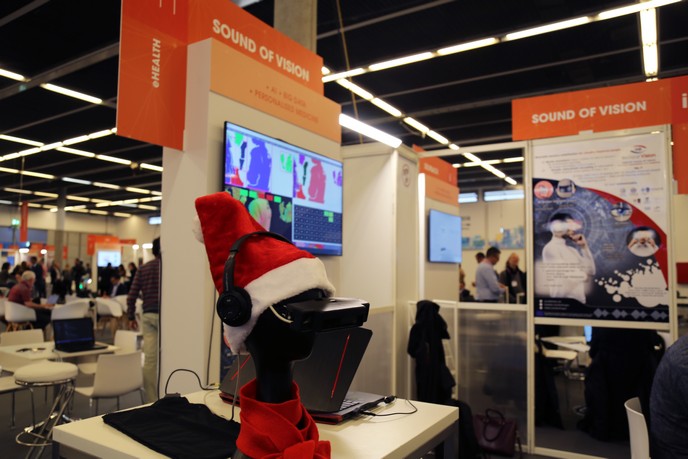How two Innovation Radar Prize winners are getting out of the lab and into the market
You can read more about the overall submissions and the winners here, but as a taste of what it takes to impress investors, CORDIS throws a spotlight on two inspirational journeys to market, outlined during the event to an expert jury. University of Iceland, winner of the Tech for Society category The University of Iceland is the coordinating institution of the Horizon 2020 Sound of Vision project, which has developed an assisted navigation package for the visually impaired that includes 3D camera head gear which scans the environment, processes data and then delivers information to users through audio feeds. It also incorporates a belt with 60 motors to generate vibrations on the torso. As official project coordinator Prof Runar Unnthorsson pointed out during his pitch, what makes the package unique is the combination of features. Especially true given that the main mobility aid for the visually impaired is still the white cane, with object detection limited to one meter in front of the user, with none at head height. The encoding is customisable, so users can choose how they receive alerts about objects such as stairs (e.g. through specific patterns of sounds). The team have undertaken over 1000 hours of training with users, including 45 visually impaired people as well as those sighted but blindfolded. There is currently a fully functioning prototype, but the team are seeking further investment to make it more wearable and fashionable, working towards having the first viable product within a year. With a potential European market of 30 million people and a sales strategy in line with health care and insurance policies, projected revenues by year two of sales is around EUR 1.3 million. CORDIS was struck by the emphasis placed on developing strong relationships with end users. As team member Simona Caraiman stressed to CORDIS, “We worked with many specialists, in neurosciences and behavioural sciences for example, but we also involved the blind community to test and evaluate the system, we made very good use of their feedback.” Indeed, the team has an extensive VR based training package and plans to roll out the technology with the support of national institutes for the blind, as well as health agencies. They are even looking at possible spin-offs for their navigational environments, such as the gaming market. NIT (New Infrared Technologies), winner of the Industrial & Enabling Tech category As CEO of NIT, Arturo Baldasano explained in his pitch, the NIT innovation improves quality assurance for the additive manufacturing (AM) processes of laser metal deposition and cladding. AM is the laser technology that builds 3D objects, by adding materials layer by layer. NIT’s innovation was developed as part of the Horizon 2020 MAShES project, which officially ended in December 2017. NIT’s patented laser-head detector controls and monitors processes to avoid problems. It does so by using high-speed infra-red cameras - operating at 1000 frames per sec, along with a real-time embedded algorithm, to adjust laser power. This means that manufacturers can respond immediately to problems by changing parameters or stopping the process, saving time and money. As Baldasano explained to the jury, there is currently no existing market, as alternative systems rely mainly on visual solutions. Additionally, the technology is compatible with almost all laser heads. After thousands of tests, NIT launched its product in July 2018 and have already sold the first units in Germany, Japan and South Korea to machine manufacturers, who have started using the product. Baldasano told CORDIS, “The way to improve this growing technology is to monitor and control the processes. In this case we are just controlling laser power but there are other things that can be controlled as well.” NIT currently also have a system to control laser welding processes. As with Sound of Vision, it is this awareness of expanded opportunities emanating from a core technology, with a focus on the end user, that stood out as hallmarks of successfully getting technology out of the lab and onto the market. As Prof Unnthorsson summarised, “First solve the problem to help people and then the technology will fall into place, getting smaller and smarter.”
Countries
Iceland



